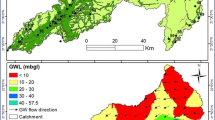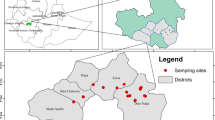Abstract
Based on the data of the depths and the chemical properties of groundwater, salinity in the soil profile, and the basic information on each delivery of water collected from the years 2000 to 2006, the varied character of groundwater chemistry and related factors were studied. The results confirmed the three stages of the variations in groundwater chemistry influenced by the intermittent water deliveries. The factors that had close relations to the variations in groundwater chemistry were the distances of monitoring wells from the water channel, the depths of the groundwater, water flux in watercourse, and the salinities in soils. The relations between chemical variation and groundwater depths indicated that the water quality was the best with the groundwater varying from 5 to 6 m. In addition, the constructive species in the study area can survive well with the depth of groundwater varying from 5 to 6 m, so the rational depth of groundwater in the lower reaches of the Tarim River should be 5 m or so. The redistribution of salts in the soil profile and its relations to the chemical properties and depths of groundwater revealed the linear water delivery at present combining with surface water supply in proper sections would promote water quality optimized and speed up the pace of ecological restoration in the study area.
Similar content being viewed by others
References
Bai, Y. (1997). A study on chemical composition of alluvial plain phreatic water in Nanjing City. Journal of Nanjing Architectural and Civil Engineering Institute, 1, 47–52.
Chen, D., Chen, X., Gu, X. H., et al. (2001). Primary discussion on hydro-chemical characteristics and formation mechanism of groundwater in Awati County. Arid Land Geography, 24(4), 376–379.
Chen, Y. J., Chen, Y. N., Liu, J., et al. (2005). Dynamical variations in groundwater chemistry influenced by intermittent water delivery at the lower reaches of the Tarim River. Journal of Geographical Sciences, 15(1), 13–19.
Chen, Y. N., Li, W. H., Xu, H. L., et al. (2003). The influence of groundwater on vegetation at the lower reaches of Tarim River. Acta Geographica Sinica, 58(4), 542–549.
Chen, Y., Wang, Q., Li, W., et al. (2006). Rational groundwater table indicated by the ecophysiological parameters of the vegetation: A case study of ecological restoration in the lower reaches of the Tarim River. Chinese Science Bulletin, 51(Suppl), 8–15. J. doi:10.1007/s11434-006-8202-3.
Chen, Y. N., Zhang, X. L., Zhu, X. M., et al. (2004). An alysis on the ecological efects of eco-water delivery to the lower reaches ofthe Tarim River,Xinjiang, China. Science in China (Ser.D), 34(5), 475–482.
Chen, Y. J., Zhou, K. F., Chen, Y. N., et al. (2008). Response of groundwater chemistry to water delivery in the lower reaches of Tarim River, Northwest China. Environmental Geology, 53, 1365–1373. doi:10.1007/s00254-007-0746-2.
Cheng, Q. C. (1993). Research on the Tarim River (pp. 35–40). Nanjing: Hehai University Press.
Fan, Z., Ma, Y., Zhang, H., et al. (2004). Research of eco-water table and rational depth of groundwater of Tarim River drainage basin. Arid Land Geography, 27(1), 8–13.
Frape, S. K., Fritz, P., & McNutt, R. H. (1984). Water–rock interaction and chemistry of groundwaters from the Canadian Shield. Geochimica et Cosmochimica Acta, 48, 1617–1627. doi:10.1016/0016-7037(84)90331-4.
Garrels, R. M., & MacKenzie, F. T. (1967). Origin of the chemical compositions of some springs and lakes. In Equilibrium concepts in natural waters. Washington, DC: American Cancer Society.
Ghobadi, M. H., Khanlari, G. R., & Djalaly, H. (2005). Seepage problems in the right abutment of the Shahid Abbaspour dam, southern Iran. Engineering Geology, 82(2), 119–126. doi:10.1016/j.enggeo.2005.09.002.
Guo, Y. J., Xu, Y. Q., & Ma, Y. H. (2002). Ecological benefits of the emergency stream water feeding to the lower reaches of Tarim River, Xinjiang. Arid Land Geography (Sheffield, England), 25, 237–240.
Hem, J. D. (1989). Study and interpretation of the chemical characteristics of natural water. U.S. Geological Survey Water-Supply Paper, 22–54.
Kristmannsdóttir, H., & Ármannsson, H. (2004). Groundwater in the Lake Myvatn area, northern Iceland: Chemistry, origin and interaction. Aquatic Ecology, 38(2), 115–128. doi:10.1023/B:AECO.0000032067.47495.71.
Li, W. H., Xu, H. L., & Aihemaiti, N. (2003). Preliminary report of water delivery and ecological restoration at the lower reaches of Tarim River. Arid Zone Research, 26, 122–128.
Li, X. Y., Zhang, Y. S., Wang, L. X., et al. (2002). Analysis of the groundwater characteristics at the lower reaches of Tarim River. Journa1 of Arid Land Resources and Environment, 16(2), 27–31.
Liao, Z. Z., & Lin, X. Y. (2004). Chemical characteristics and variations of groundwater quality in Songnen Basin. Earth Science—Journal of China University of Geosciences, 29(1), 96–102.
Liu, J. Z., & Chen, Y. N. (2002). Analysis on the converse succession of plant communities at the lower reaches of Tarim River. Arid Land Geography, 25, 231–236.
Liu, Y. L., Jiao, G. H., Dai, J., et al. (2000). Report on field survey of middle and lower reaches of Tarim River (pp. 163–178). Beijing: China Statistics Press.
Rodriguez, R., & Candela, L. (2004). Changes in groundwater chemistry due to metallurgical activities in an alluvial aquifer in the Moa area (Cuba). Environmental Geology, 46(1), 71–82.
Song, Y., Fan, Z., Lei, Z., et al. (2000). Research on water resources and ecology of Tarim River, China (pp. 145–146). Urumqi: People’s Press of Xinjiang.
Thomas, J. M., Welch, A. H., & Preissler, A. M. (1989). Geochemical evolution of ground water in Smith Creek Valley—a hydrologically closed basin in central Nevada. USA Applied Geochemistry, 4, 493–510. doi:10.1016/0883-2927(89)90007-3.
Wang, G. L., Lin, W. J., & Zhang, F. W. (2004). The environmental evolution of groundwater in Taihang Mountain—footplain of North China. Journal of Arid Land Resources and Environment, 18(3), 74–77.
Wang, Q., Ruan, X., Chen, Y., et al. (2007). Eco-physiological response of Populus euphratica Oliv. to water release of the lower reaches of the Tarim River, China. Environmental Geology, 53, 349–357. doi:10.1007/s00254-007-0650-9.
Wei, Z. D. (1981). The characteristics of shallow ground water chemistry in belt. Hydrological Geology and Engineering Geology, 5, 15–20.
Wen, X. H., Wu, Y. Q., & Chang, J. (2004). Analysis on the spatial differentiation of hydrochemical characteristics in the Heihe River watershed. Arid Zone Research, 21(1), 1–6.
White, A. F., Claassen, H. C., & Benson, L. V. (1980). The effect of dissolution of volcanic glass on the water chemistry in a tuffaceous aquifer, Rainer Mesa, Nevada. U.S. Geological Survey Water-Supply Paper, 1535–1557.
Xu, H. L., Chen, Y. N., & Li, W. H. (2003). Study on the response of groundwater after water translation at the lower reaches of Tarim River. Research of Environmental Sciences, 16, 19–22.
Xu, H. L., Song, Y. D., Li, W. H., et al. (2004). The dynamics of water and salt after ecological water transport to the lower reaches of Tarim River. Journal of Arid Land Resources and Environment, 18(3), 63–67.
Zhang, H. F., Li, W. H., Ge, H. T., et al. (2003). Compositor analysis on correlation between groundwater level and water chemical contents at the lower reaches of Tarim River. Arid Land Geography, 26, 260–263.
Zhang, Y. M., Chen, Y. N., & Pan, B. R. (2005). Distribution and floristics of desert plant communities in the lower reaches of Tarim River, southern Xinjiang, People’s Republic of China. Journal of Arid Environments, 63, 772–784. doi:10.1016/j.jaridenv.2005.03.023.
Author information
Authors and Affiliations
Corresponding author
Rights and permissions
About this article
Cite this article
Chen, Yj., Chen, Yn., Liu, Jz. et al. Influence of intermittent water releases on groundwater chemistry at the lower reaches of the Tarim River, China. Environ Monit Assess 158, 251–264 (2009). https://doi.org/10.1007/s10661-008-0579-9
Received:
Accepted:
Published:
Issue Date:
DOI: https://doi.org/10.1007/s10661-008-0579-9




